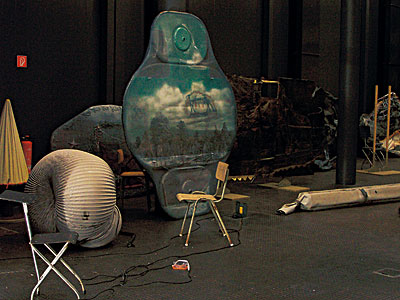| Revista Umělec 2005/2 >> Christian Riebe - Seven Worn Mundane Objects Shining in the Front Yard | Lista de todas las ediciones | ||||||||||||
|
|||||||||||||
Christian Riebe - Seven Worn Mundane Objects Shining in the Front YardRevista Umělec 2005/201.02.2005 Halka Třešňáková | revolutionary DIY | en cs de |
|||||||||||||
|
Labore in Secreto
Born in 1963 in Lübeck, Christian Riebe currently lives and works in Hannover. Not only does he feel lost in this office-ridden German city, he is lost in time in his own way. Between 1984 and 1990 he studied painting at the art school in Hannover and, to this day, he teaches painting there. The school was later moved from an old building in the non-existent center of Hannover to another one full of offices decaying, in a Kafkaesque manner, in the outskirts of the city. Since then, the school has been sharing this building allocated to it by the city with a construction company; every year it loses some of its rooms and spaces. The cafeteria is split in two by a mobile screen separating office workers from the art school students, who wait for food in dwindling numbers. German city outskirts are completely different from the images we have formed about other cities—from literature or films—or how we have imagined them in our own fantasies (or reality?) with gangs and criminality. They are the German periphery, full of offices and new housing developments; they are clean, without dead bodies and, surprisingly, without excrement everywhere. The employees go into their offices in the morning and in the evening they leave their offices and return home, away from this dreary pseudo-life. That is, all except for some night guards and porters, a few lovers, and those condemned to this apocalyptical reality—such as Christian Riebe. In school, he had already gone into exile into his own mind to flee the fruitless talks about art that, in their own self-expedience, manage to create its own grammar. The majority of contemporary artists, who try to rediscover conceptual or abstract techniques appear to him – from his on-looking ego – to be on a “tiresome march of good craftsmen.” Apparently his mental internal exile didn’t lead him to the end of the world, or the periphery, but instead to the fashion of art history. And those who know the unfinished documentation of the ‘parallel art history’ of the amateurs and folk art, find in Riebe’s pictures typical aspects of the art of mentally ill patients, and the compositional elements of votive pictures. The treatment and structuring of his drawings and pictures has become increasingly raw and ruthless. Some of his prints undergo several stages of development, starting with blackening of the whole format, across which he has painted, written and drawn with white tempera, and he continues in this process. The motifs escape from being marginalized fighting the artist’s urge to correct them by pushing them to the edges of the picture, or they suddenly appear from the lower layers of the paper through the cracks and tears in the upper layers. As Riebe says, his work is not about succumbing to the temptation to blacken the paper up to the edges of the picture. Thematically related cycles of mostly black-gray-white drawings, combined with tempera, remnants of outcries and inscriptions, and layers of paper and papiermache are joined in huge formats of wall pictures whose contents and meanings can be read as if from a torn comic on a large surface. The style of this environment, the periphery of Hannover, the esthetic of the employees-only back entrance of a shopping center or Ikea, of a desolate highway on-ramp without any patina of time, or warehouses built next to the row houses in Prague in the neighborhood Říčany, is typical for present day Germany. To perceive this hyperreality as an inspiration and as a life partner – shows the great creative power of Christian Riebe and predestines his exceptionality and individuality as an artist. It is such places that become the main motif of his work. The titles of his work, such as On the Sewer, At the Soap-Factory, Border Crossing with Beehives and others, refer to this. His work emerges from a melancholic inventory of discarded non-functioning home appliances, shoes and pots heaped into a colorful mosaic together with socks, creating vague forms for cakes, which make their way through small floodgates and conservatories, as if through a mincing machine, just as we can see in a similar object called Seven Worn Mundane Objects Shining in the Front Yard.
01.02.2005
Artículos recomendados
|
|||||||||||||









Comentarios
Actualmente no hay comentariosAgregar nuevo comentario